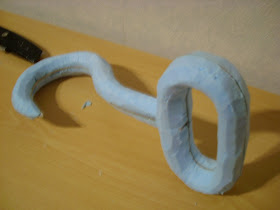Oh, Halloween. What a great excuse to make a costume. Three years ago I made a version of Bubblehead Nurse and last year Miss Samara “Well” Morgan. This year by project is Baby Jane Splicer from Bioshock. I’m doing an early concept art version from the character, because I just find the messy red hair more appealing that the black bob.
Because I’m constantly looking for different ways to make hard props, I thought to try something new when building the meat hooks for Baby Jane. The basic construction method is pretty common, pulp board skeleton with foam cover, but the finishing is slightly different. (Read: constantly looking for ways to eliminate sanding.)
First thing to do before the build is to define the shape of the hooks. I could have studied the references before cutting the skeleton, but I trusted my memory, which again proved to be little off. My handles are like 0 when they should be like D. But I chose to let it pass this time, because the costume is not for competition purposes, only for fun.
1: The pulp board
I made the skeleton from two parts; hook and handle. The design of the hooks is pretty bulky, so I chose the width to be about 1,7 cm. One centimeter diameter would have made the hook look too frail and 1,5 was not enough, but with two centimeters it would have been just huge, at least for a lady character. I don't really know why I ended up with 1,7, it just worked.
 Before gluing the pieces together, the shapes are traced on insulation foam. Both parts two times.
Before gluing the pieces together, the shapes are traced on insulation foam. Both parts two times.

After I had cut the pieces, I sliced a slit on the hook and glued it to the handle. The structure may seem floppy at this point, but when the foam is added there will be more support on the cross part.
2: The foam
I used 2 cm thick insulation foam. The traced pieces are cut out. First the handle parts are glued. Then small slits are cut so that the crossing parts are sealed underneath. The sandwich is taped together. The glue needs to dry before anything else can be done.
 Then it’s time to start cutting away the excess foam. I used a carpet knife and naturally cut myself during the first few minutes. So use gloves to protect your precious fingers, because sharper the knife is the neater the result will be. With dull blade you just end up ripping the foam.
Then it’s time to start cutting away the excess foam. I used a carpet knife and naturally cut myself during the first few minutes. So use gloves to protect your precious fingers, because sharper the knife is the neater the result will be. With dull blade you just end up ripping the foam.
 The pulp board works as a guideline when the foam is cut round from the both sides. Some of the height needs to be taken away, because the hook should be 1,7 cm diameter all around. It’s better to cut less than more. The shape is finished with fine sand paper.
The pulp board works as a guideline when the foam is cut round from the both sides. Some of the height needs to be taken away, because the hook should be 1,7 cm diameter all around. It’s better to cut less than more. The shape is finished with fine sand paper.

3: Paper Mache
You can use any adhesive you like for this. I just simply mixed together glue and water until I got the consistence I was happy with. It’s always best to start with glue and add water little by little. Ripped pieces of newspaper are dipped in the adhesive and laid on the foam. On curves the pieces need to be small so that they sit properly. Two to three layers will do.

I normally avoid this enforcement technique, because I never seem to get the surface as smooth as I would like to. But because the meat hook can look rough, the few bumps I was able to create didn’t bother me.
4: Coating
For the coating I used water, glue and wood putty in form of a goo. Goo in this case means a spread that is liquid enough to be applied with a brush, but also pasty enough so that it doesn’t drip. I went with gut feeling and didn’t measure anything. I still have to do the other hook, so I try to take notes and add information later about the amounts. The goo will last for few days under plastic.

The goo is spread thinly on the hook. Each layer should be dry before the next. I think I made three to four layers in total. And then it’s done; a meat hook to be painted and weathered.
Notes:
I’m going to paint my hooks with acrylics and will post photos of them when they are done. For the construction; you could use expanding foam instead of insulation foam. The finish could be just putty, but you would probably need to sand it. And if you hate sanding and refuse to do it, you could skip it with the insulation foam; your hook might only look rougher in that case.











